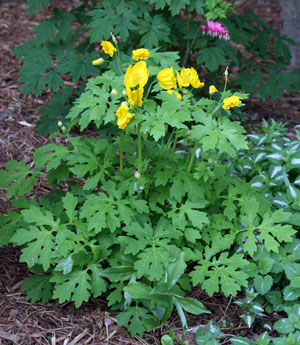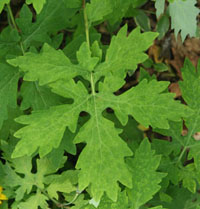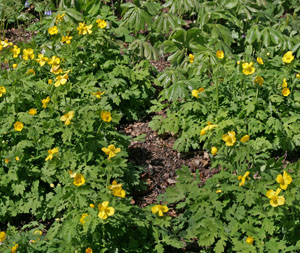
The bright yellow flowers of Stylophorum diphyllum, commonly called celandine poppy or wood poppy, make a splash in spring and early summer. This herbaceous perennial in the poppy family (Papaveraceae) is native to moist woodlands of eastern North America, from zone 4 to 9. It is found in low-elevation deciduous forests from Ontario, Canada and Pennsylvania south to Kentucky, north Alabama and Georgia and west to Michigan and Missouri, typically in open woods at the base of bluffs, along streams, and in ravine bottoms with rich soils. It is one of the plants that is adversely affected by invasive garlic mustard (Alliaria petiolata) and habitat destruction, and is considered threatened or endangered in many areas. This showy, relatively long-lived wildflower adapts easily to the flower garden so it is often grown as an ornamental in beds as well as in naturalistic plantings.

There are two other species in the genus (S. lasiandrum and S. sutchuenense), both from China, but neither are readily available or as ornamental as S. diphyllum. The similar Celandine (Chelidonium majus), also in the poppy family, is a somewhat weedy European biennial that has smaller flowers (¾” across or less) that bloom in summer and hairless, erect seed capsules.
Celandine poppy grows 1-1½ feet tall and spreads up to a foot across. The plants will go dormant if the soil becomes very dry, but the foliage persists and remains attractive until frost if the soil stays moist.

Plants grow from a woody caudex and thick, rhizomatous roots. Basal leaves are up to 6″ long and 2½” across with long and conspicuously hairy petioles. The dark bluish-green leaves are double pinnate with rounded lobes – each leaf has 2-3 pairs of deep primary lobes and each of those lobes has shallow secondary lobes. The underside of the basal foliage is silvery with fine hairs. The bright yellow to orange sap in the stems was used by Native Americans as a dye (and can stain hands).
The bright yellow to yellow-orange flowers are produced in large numbers in early spring. The blossoms are borne in small clusters (floppy terminal umbels) on the ends of 12-18” stems that are leafless except for a pair of opposite leaves subtending the inflorescence. The stems may have a purple base and are covered with fine hairs, giving them a bristly appearance. Each 1-2” buttercup-like flower has four petal-like sepals (true petals are absent) that spread open around the numerous, erect stamens with yellow anthers and the longer single style (a yellow-green pistil with a knobby stigma). If plants are deadheaded they will bloom intermittently throughout the summer, especially if kept watered. Cut off the flower stems after the blooms fade to encourage the plants to send up more flowers.

Flowers that are pollinated – likely by bees – and remain on the plant will form a pendant, dehiscent fruit about an inch long. The ovoid, hairy or fuzzy-looking fruits have four chambers that are filled with shiny, dark brown to black seeds. The seeds, each with a distinctive ridge of white hairs, are released when the seed capsules split apart in mid to late summer. The seeds are naturally dispersed by ants.

Celandine poppy is well suited to shaded perennials beds, native plant gardens, and for naturalizing in moist woodlands. Use it as a showpiece in a wildflower garden or along a shady path. The bold foliage of celadine poppy is a nice contrast of texture when planted among large-leaved hostas. It combines well with other shade-loving plants including bleeding heart (Dicentra spp.), columbine (Aquilegia spp.), foamflower (Tiarella spp.), spiderworts (Tradescantia spp.) and wild ginger (Asarum spp.). Because it tolerates moist soils, it could be used in a shady rain garden.
Place celandine poppy where it will receive sun in the early spring before the trees fully leaf out, but dappled shade later in the year. Even though it does best in moist, humus-rich soil, it is fairly drought tolerant once established and can do well in dry shade without supplemental watering (although it may go dormant under those conditions).

This species can be propagated by division or by seed. Although it will self seed, it is not particularly aggressive and unwanted plants are easily pulled up. Seeds need

moist stratification to germinate, so either sow in the fall in a cold frame, or place them in moistened potting medium in the refrigerator for several weeks. Plants may flower in their first year, but usually don’t do so in the wild. Once established, plants survive for many years, forming dense clumps if not thinned.
Take divisions from established plants in spring, being sure to include a growing point with each piece. It does not have any serious insect or disease problems (slugs may occasionally attack plants), and because the foliage is toxic, it is avoided by deer and other mammalian herbivores.
– Susan Mahr, University of Wisconsin – Madison
Latest from Wisconsin Yard & Garden
Ask Your Gardening Question
If you’re unable to find the information you need, please submit your gardening question here:





 Aster, Symphyotrichum spp.
Aster, Symphyotrichum spp. Fascinating Fasciation
Fascinating Fasciation Alternatives to Lawn: Groundcovers
Alternatives to Lawn: Groundcovers Marigolds
Marigolds


